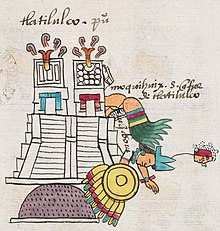Tlatelolco (altepetl)
Mexico-Tlatelolco | |
|---|---|
| 1337–1473 | |
| Common languages | Nahuatl |
| Religion | Pre-Columbian Nahua religion |
| Government | Monarchy |
| Tlatoani | |
• 1376–1417 | Quaquapitzahuac |
• 1417–1428 | Tlacateotl |
• 1428–1460 | Quauhtlatoa |
• 1460–1473 | Moquihuix |
• 1475–1520 | Itzquauhtzin |
| Historical era | Pre-Columbian |
• Established | 1337 |
| 1473 | |

Tlatelolco (Template:Lang-nci-IPA, ) (also called Mexico Tlatelolco) was a prehispanic altepetl or city-state, in the Valley of Mexico. Its inhabitants were known as Tlatelolca. The Tlatelolca were a part of the Mexica, a Nahuatl-speaking people who arrived in what is now central Mexico in the 13th century. The Mexica settled on an island in Lake Texcoco, founding the altepetl of Mexico-Tenochtitlan on the southern portion of the island. In 1337, a group of dissident Mexica broke away from the Tenochca leadership in Tenochtitlan and founded Mexico-Tlatelolco on the northern portion of the island. Tenochtitlan was closely tied with its sister city, which was largely dependent on the market of Tlatelolco, the most important site of commerce in the area.[1]
History


In 1337, thirteen years after the foundation of Tenochtitlan, the Tlatelolca declared themselves independent from the Tenochca and inaugurated their first independent tlatoani (dynastic ruler). Under the king Quaquapitzahuac (1376–1417), the first two stages of the Main Pyramid of Tlatelolco were constructed. Under Tlacateotl (1417–1428), the Tlatelolca assisted the Tenochca in the war against the Tepanec empire, dominated by Azcapotzalco. Shortly thereafter, the first war between the Tenochca and Tlatelolca erupted. Also during Tlacateotl's reign, the third stage of the Main Pyramid was constructed. Under Quauhtlatoa (1428–1460), the Tlatelolca conquered the city-state of Ahuilizapan (now Orizaba, Veracruz), and fought against the people of Chalco along with the Tenochca. The fourth and fifth stages of the Main Pyramid were constructed in this period. The ruler Moquihuix (1460–1473) constructed the sixth stage of the temple, but in 1473, in the Battle of Tlatelolco, he was defeated by the Tenochca tlatoani Axayacatl, and Tlatelolco was made subject to Tenochtitlan. Itzcuauhtzin ruled Tlatelolco during a period in which it was almost completely incorporated into Tenochtitlan.[2]: 65
After the completion of the two-year Spanish Conquest of the Aztec Empire in 1521, the Spanish conquerors established the ruins of Mexico-Tenochtitlan as the Spanish capital of New Spain. The remnants of the indigenous populations of Tenochtitlan and Tlatelolco following the conquest were administered by indigenous elites in the incorporated Indian towns of Santiago Tlatelolco and San Juan Tenochtitlan. Tlatelolco remained an important location in the colonial era, partly because of the foundation there, of the school for elite indigenous men, the Colegio de Santa Cruz de Tlatelolco, which was the first school of higher learning in the Americas. Today its remains are located within Mexico City.
In the twentieth and twenty-first centuries, archeological excavations have taken place at the Tlatelolco (archaeological site) in what is now part of Mexico City. The excavations of the prehispanic city-state are centered on the Plaza de las Tres Culturas, a square surrounded on three sides by an excavated Aztec site, a 17th-century church called Templo de Santiago, and the modern office complex of the Mexican foreign ministry. In February 2009, the discovery of a mass grave with 49 human bodies was announced by archaeologists. The grave is considered unusual because the bodies are laid out ritually.[3]
Notes
- ^ Matos Moctezuma, Eduardo. "Tlatelolco". The Oxford Encyclopedia of Mesoamerican Culture, vol. 3, pp. 230-31.
- ^ León-Portilla, M. 1992, 'The Broken Spears: The Aztec Accounts of the Conquest of Mexico. Boston: Beacon Press, ISBN 978-0807055014
- ^ "Aztec 'warrior' mass grave found". BBC. 12 February 2009.
Further reading
- Anales de Tlatelolco, unos annales históricos de la nación mexicana y Códice de Tlatelolco. Edited by Heinrich Berlin and Robert H. Barlow. Mexico 1948.
- Barlow, Robert H. Tlatelolco, rival de Tenochtitlan. Edited by Jesús Monjarás-Ruiz, Elena Limón, and María de la Cruz Paillés Hernández. Mexico City and Puebla 1987.
- Castañeda de la Paz, María (2008). "Apropiación de Elementos y Símbolos de Legitimidad entre la Nobleza Indígena. El Caso Del Cacicazgo Tlatelolca." Anuario De Estudios Americanos. Directory of Open Access Journals.
- Chimalpahin Cuauhtlehuantzin, Domingo Francisco de San Antón Muñon. Codex Chimalpahiin: Society and Politics in Mexico Tenochtitlan, Tlatelolco, Texcoco, Culhuacan, and Other Nahua Altepetl in Central Mexico. Arthur J.O. Anderson et al. Norman, Oklahoma: University of Oklahoma Press 1997.
- Garduño, Ana. Conflictos y alianzas entre Tlatelolco y Tenochtitlan. Mexico City 1998.
- Guilliem Arroyo, Salvador. Ofrendas a Ehecatll-Quetzalcoatl en Tlatelolco. Coleccion Científica INAH Num. 400. 1999. Mexico.
- Matos Moctezuma, Eduardo. "Tlatelolco" in The Oxford Encyclopedia of Mesoamerican Culture, vol. 3, pp. 230–31. Oxford University Press 2001.
See also
- Altepetl
- Tlatoque of Tlatelolco
- Valley of Mexico
- History of the Aztecs
- 14th century in the Aztec civilization
- 15th century in the Aztec civilization
- 1500s in the Aztec civilization
- 1510s in the Aztec civilization
- 1520s in the Aztec civilization
- States and territories established in 1337
- States and territories disestablished in the 1470s
- 14th-century establishments in Mexico
- 15th-century disestablishments in Mexico
- 1337 establishments
- 1473 disestablishments
- States and territories disestablished in 1521
- 1521 disestablishments in Mexico
